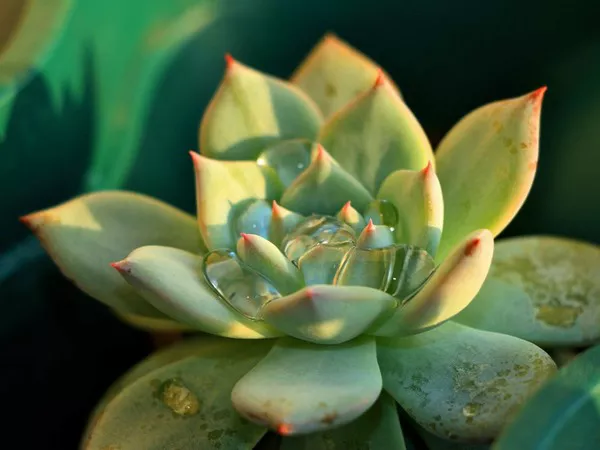Succulent plants have garnered immense popularity for their unique appearance, easy maintenance, and versatility in various environments. However, like all living organisms, succulents require proper care to thrive and display their vibrant beauty. Whether you’re a seasoned gardener or a newcomer to the world of plants, understanding the intricacies of succulent care is essential. This comprehensive guide delves into the fundamental aspects of caring for succulent plants and provides valuable insights into related topics that contribute to successful succulent cultivation.
Understanding Succulents: What Sets Them Apart
Succulents are plants that have adapted to arid conditions by storing water in their leaves, stems, or roots. This unique adaptation allows them to survive extended periods of drought. The key characteristics that set succulents apart from other plants include:
1. Fleshy Tissues
Succulents typically feature fleshy leaves, stems, or both, which serve as reservoirs for storing water. This adaptation enables them to endure harsh conditions where water is scarce.
2. Diverse Shapes and Sizes
Succulents come in a wide range of shapes, sizes, and colors. From the compact rosette forms of Echeverias to the trailing tendrils of String of Pearls, the diversity within the succulent family is astounding.
3. Sun-Loving Nature
Most succulents thrive in bright sunlight. Their ability to tolerate intense sunlight makes them excellent choices for gardens, window sills, and outdoor landscapes.
4. Minimal Water Requirements
Due to their water storage abilities, succulents have low water requirements. Overwatering can lead to root rot and other issues, making it crucial to understand their specific needs.
Essential Care Guidelines for Succulent Plants
Caring for succulents involves a combination of understanding their needs and providing appropriate conditions. Following these fundamental guidelines will help you ensure the health and vitality of your succulent plants:
1. Light and Placement
Succulents thrive in bright sunlight. Place them in locations where they receive at least six hours of indirect sunlight per day. While some varieties can tolerate direct sunlight, it’s important to acclimate your plants gradually to prevent sunburn.
2. Well-Draining Soil
Use well-draining soil mixes formulated for succulents. These mixes often contain materials like perlite, sand, or pumice, which promote proper water drainage. Plant your succulents in pots with drainage holes to prevent water accumulation at the root zone.
3. Watering Wisely
Allow the soil to dry out completely between waterings. Water your succulents thoroughly, but infrequently. The frequency of watering depends on factors such as the plant’s size, location, and environmental conditions. It’s better to underwater than overwater, as succulents are susceptible to root rot caused by excess moisture.
4. Temperature Considerations
Most succulents thrive in temperatures between 60°F and 80°F (15°C to 27°C). While they can tolerate temperature fluctuations, it’s best to protect them from frost and extreme heat. Indoor environments with stable temperatures are usually suitable for succulents.
5. Container Selection
Choose containers with drainage holes to prevent waterlogging. The size of the pot should allow room for the plant to grow, but not be excessively large. Terracotta pots are a popular choice as they allow for breathability and provide a rustic aesthetic.
6. Pruning and Maintenance
Remove dead or dying leaves regularly to maintain plant health and appearance. Pruning also helps prevent pests and diseases from taking hold. Some succulents may benefit from occasional grooming to maintain their desired shape.
Deeper Dive: Propagation Techniques for Succulents
Propagating succulents is a rewarding way to expand your collection or share your plants with others. Several methods can be employed to propagate succulents successfully:
1. Leaf Propagation
Many succulents can be propagated from leaves. Gently remove a healthy leaf from the plant and allow it to air dry for a day or two. Place the dried leaf on well-draining soil, mist it occasionally, and new roots and baby plants will develop.
2. Offsets and Pups
Some succulents produce offsets or pups that can be separated and planted. These are small plants that grow at the base of the parent plant. Carefully detach them from the parent and let the cuttings callus before planting.
3. Stem Cuttings
Certain succulents can be propagated from stem cuttings. Snip a healthy stem, allow it to dry, and plant it in well-draining soil. Be patient as roots and new growth develop.
Succulents in Interior Design and Landscaping
Succulents have gained immense popularity not only for their resilience but also for their aesthetic appeal. Incorporating succulents into interior design and landscaping projects opens up a world of creative possibilities:
1. Indoor Arrangements
Succulents make excellent indoor plants. Create eye-catching arrangements by combining different succulent varieties in decorative pots or planters. Consider using vertical wall planters for space-saving greenery.
2. Table Centerpieces
Succulents can serve as unique and long-lasting table centerpieces. Place them in decorative containers and add elements like pebbles or decorative rocks to enhance their visual appeal.
3. Xeriscaping
In landscaping, succulents are ideal for xeriscaping projects. Their water-efficient nature makes them perfect for creating low-maintenance and water-wise landscapes.
4. Living Walls and Vertical Gardens
Create stunning living walls and vertical gardens using succulents. Their varied colors and forms add texture and visual interest to vertical arrangements.
Conclusion
Mastering the art of succulent care is a journey that offers both challenges and rewards. By understanding the unique traits of succulents and tailoring their care to match their requirements, you can cultivate thriving and beautiful plants. Whether you’re tending to a small windowsill collection or designing a large-scale landscaping project, the principles of succulent care remain consistent. Remember, observation and responsiveness are key; paying attention to your plants’ responses will guide you in providing the best care possible. With proper light, well-draining soil, appropriate watering, and a touch of creativity, your succulents will flourish, showcasing their distinctive charm and enhancing any environment they grace.


